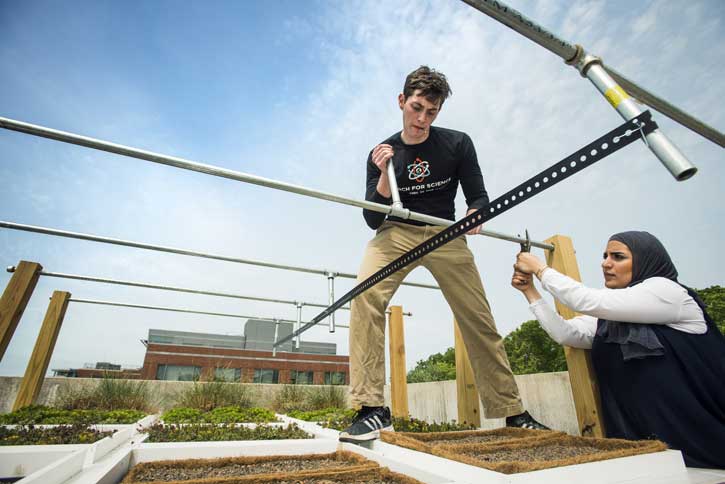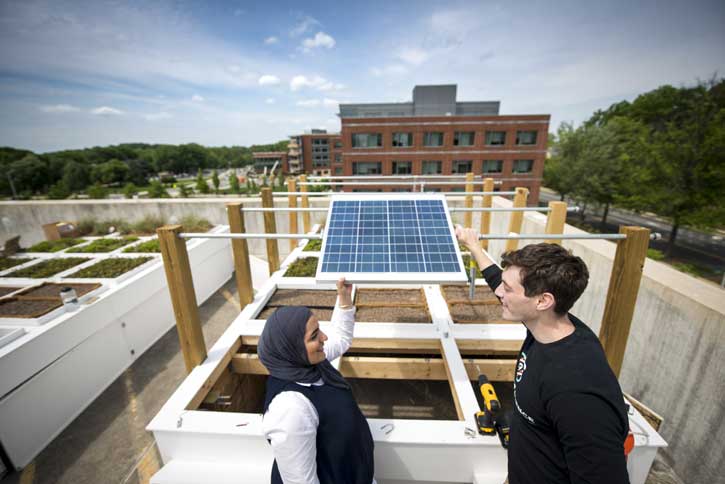
Andrew Sachs, integrative studies, collaborates with Alia Gholoom, civil and infrastructure engineering, on construction of a green roof on top of the Rappahannock Parking Deck. Photo by Evan Cantwell.
Recently, George Mason University’s Rappahannock Parking Deck got a new roof—a green roof, to be specific, as part of a graduate research project.
A green roof is a roof of a building or structure that is partially or completely covered in vegetation and a growing media that is built over a waterproof surface.
The project will examine different aspects of environmental sustainability in infrastructure, led by professors Paul Houser in the Department of Geography and Geoinformation Science, Viviana Maggioni in the Sid and Reva Dewberry Department of Civil, Environmental and Infrastructure Engineering and Dann Sklarew in the Department of Environmental Science and Policy.
The professors received funding for the project last spring, with education and research grants totaling $40,000 from the Dominion Foundation and the Patriot Green Fund. The grants, according to Maggioni, have helped fund the tools to create the roof and instrumentation to collect assorted data.
The roof was built with the assistance of two graduate students, who will be conducting their own research on different aspects of the roof.
Alia Gholoom, a master’s student in civil and infrastructure engineering, hopes to gain a better understanding of how green roofs perform, particularly in combination with solar panels installed on one part of the roof. Her role will focus on adding elements like the panels to the traditional green roof structure to see how they can become more efficient.
Gholoom would like to see the results of the research be used as a way for public works and private citizens to decide if installing a green roof would be beneficial to their communities.
“Green roofs are going to be a very vital part of this effort to ‘green’ our cities but there’s a lack of research,” said Andrew Sachs, an accelerated master’s environmental science and public policy student.
Sachs works with green infrastructure and wants to see how structural aspects of the roof, like insulation and storm water prevention, can make the roof more efficient. Though not a lot of research has been conducted on green roofs, Sachs believes they will be vital in an effort to green cities nationwide.
“In the ever-challenging realm of climate change and urbanization, it’s going to be a lot more important for regulatory use to know exactly what [elements of the roof] are contributing to [which results],” Sachs said.
Maggioni said the project offers opportunities for cross-collaboration between disciplines and students.
The green roof is interdisciplinary, bringing together students from geography, engineering and environmental science programs to examine the possible impacts of a green roof on a community. It also provides professors with the opportunity to get their students involved in studying and assisting with the roof, from undergraduates working on accelerated master’s degrees to PhD students.
“For me, the most important outcome of this project is to have my students have a unique experience, in terms of learning, and once they leave Mason, taking this experience with them,” Maggioni said.
The roof will be completely operational in the coming months, and plans are for it to endure for as long as Mason students can use it for research.

Alia Gholoom and Andrew Sachs with a solar panel that's part of the green roof project on the Rappahannock Parking Deck. Photo by Evan Cantwell.
